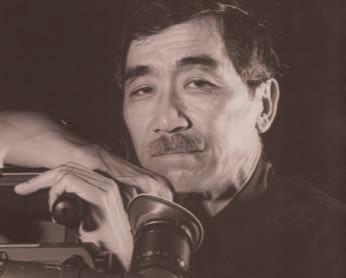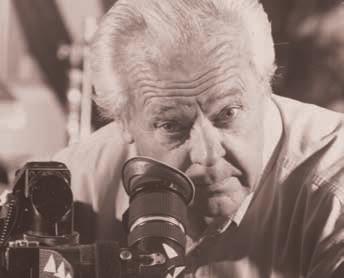
5 minute read
The Masters
2017 is not only the CSC’s 60 th anniversary, it also marks 30 years of recognizing extraordinary excellence through the CSC’s Masters Award. This special honour is conferred upon cinematographers who have transcended from just practicing their craft into leaders of their craft by influencing the cinematic art form through their exceptional creativity, technical skills and ingenuity. Originally called the Kodak New Century Award, it was renamed the Masters Award in 2014 to reflect industry changes brought about by the digital age.
In celebration of the CSC’s 60 th anniversary, Canadian Cinematographer is presenting a 10-part series on the exceptional cinematographers who have received the Masters Award. This is part three.
By Guido Kondruss
George Morita csc 1993
George Morita csc was born in 1937 to Japanese parents who ran a poultry farm near Chemainus, British Columbia. After the bombing of Pearl Harbor by Japan, the Morita family was uprooted and sent to an internment camp in the B.C. interior for the duration of the Second World War. With the arrival of peace, Morita’s parents were given the choice of repatriation to Japan or passage to eastern Canada. Moving to Japan was inconceivable for the family, since Morita’s father had been living in Canada for the past 40 years and all the children were born in Canada. Toronto became their new home. At age 13, Morita’s journey into film began when he bought a $3 Kodak Baby Brownie camera. Right from Morita’s first roll of film, he began experimenting, shooting double exposures to capture a friend boxing with himself. After graduating from the art program at Central Technical School, Morita landed a job as an ad agency artist. However, when an opening beckoned at a production company, Morita jumped at the chance to become part of Toronto’s nascent film industry. He was a gofer, animator, focus puller and eventually a camera assistant, working on commercials, documentaries and features. By 1965, Morita had transitioned to a cinematographer and began making waves in the commercials world. He became known for his simplified but highly effective lighting style, using a key light and a negative bounce technique. Morita was also considered a technical wizard, who could bring to life the most improbably shot or complicated concept. Besides being a topflight DP, Morita also turned his talents to directing. He was one of the founders of the legendary Partners Film company and later a co-owner of Avion Films. During his 45-year career, Morita shot and directed nearly 3,000 commercial spots, collecting a treasure trove of awards that include Clios, Bessies, U.S. TV and radio awards and a bronze Lion from Cannes. Morita is retired and lives with his wife in Campbellville, Ontario.
Roger Moride csc 1994
Roger Moride csc was born in 1923 near the town of Quimper in the Brittany region of France. As a young boy, Moride learned basic English from the British tourists who flocked to Brittany each year. It was a skill that would loom large in his later life. As a young adult in Paris, Moride wasn’t sure about his future path, but at the urging of a friend, he applied and was admitted in 1943 to the École Technique de Photographie et Cinématographie. After graduating, it was clear to Moride that cinematography was calling, and he spent two more years learning his craft at the Hautes Études Cinématographiques. Moride entered the French film industry as a camera assistant, working on several features including Jacques Tati’s classic comedy Jour de fête. By the early 1950s, Moride was a cinematographer shooting documentaries in Europe and Brazil when he was offered a job by the National Film Board of Canada. They were looking for a cinematographer who could speak French and English. Moride arrived in Montreal in 1954 for a two-year stay, but he met a Canadian woman. They married, and Canada became Moride’s permanent home. The NFB offered Moride a staff position and more documentaries, but he had different ideas. Moride wanted to pursue other film formats to indulge his passion for lighting in both English and Quebec cinema. Moride was soon in demand for his technical and artistic abilities. With his classical lighting style, Moride could sculpt a shot to perfection. He also had an intuitive eye for framing, much in the same way great painters had an instinct for composition. Through his masterful use of graduated filters, Moride could subtly add highlights to the visual look of a film or completely change its atmosphere. During his career as a top Canadian cinematographer, Moride shot dozens of features, television series, documentaries and more than 120 commercials. Moride is retired and lives in Montreal.

Laszlo George csc, hsc 1995
Although born in Budapest in 1931, Laszlo George csc, hsc was raised by his grandparents in the village of Bozsok near the Hungarian-Austria border. It was also a village with no electricity. For the early part of his life, Laszlo was surrounded by candles and lanterns for illumination, and it was the dancing flames casting unpredictable shadows that sparked his lifelong fascination with light. Laszlo’s interest in film and cinematography was piqued in high school when he became class projectionist, captivated by the images cast on the screen from 16 mm Russian movies. His growing love for film led Laszlo to enroll in the renowned Budapest Academy of Film and Dramatic Arts. At the Academy, Laszlo studied all the aspects of filmmaking, as well as art history courses. He was particularly drawn to Renaissance painters, especially Caravaggio with his use of shadowing from a single light source. As a cinematographer, Laszlo adapted and modified this technique into his own unique style. After graduation, Laszlo managed to make one short film before Russian tanks rolled into Budapest, quelling the Hungarian uprising of 1956. Like many other Hungarians, Laszlo fled to the West, eventually making his way to Toronto. Within a month of his arrival, Laszlo was shooting news film and later, commercials, one of which garnered him a Clio Award for his cinematography. Laszlo was part of the cinematography team that shot the 1967 groundbreaking film A Place to Stand, which won an Oscar for Best Live Action Short. While Laszlo shot numerous features, TV series, and ventured into IMAX cinematography, it was with television movies that he hit his stride, as the DP on more than 100 productions. During his career, Laszlo received numerous honours for his outstanding cinematography, including two CSC Awards and a Canadian Film Association Award. Laszlo is semi-retired and lives with his wife in Lions Bay, British Columbia.


